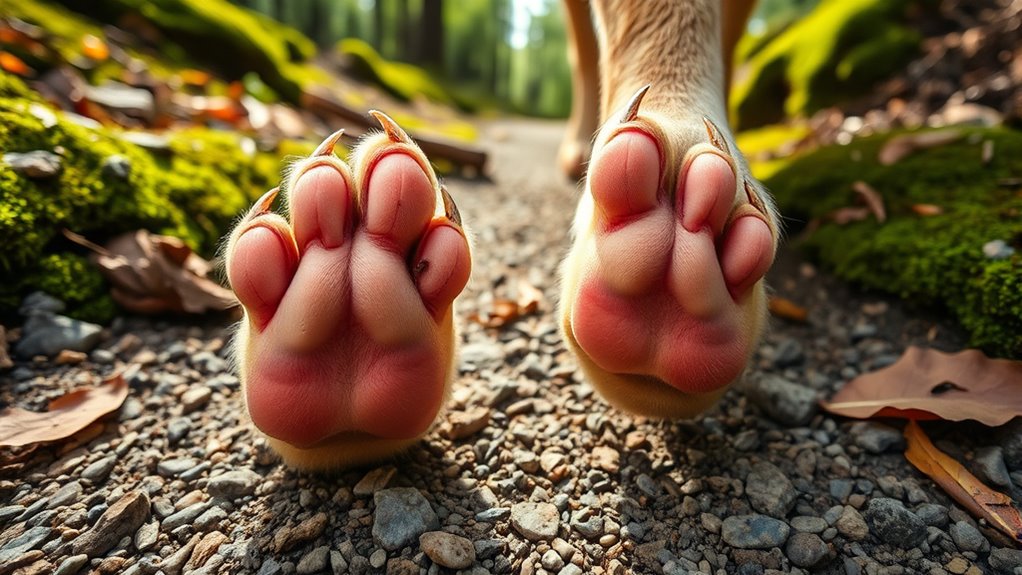To keep your dog’s tender pads safe, avoid rocky or uneven terrains with sharp edges, loose stones, or rough surfaces, as they can cause cuts, bruises, or tears. Hot pavement during peak sunlight hours can burn paws quickly, so steer clear of asphalt or concrete on hot days. Instead, choose softer, shaded pathways like grass, mulch, or gravel to protect your pup’s paws. Continuing now will help you identify even more paw-friendly options.
Key Takeaways
- Rocky and jagged terrains with sharp edges can cause cuts and punctures on tender pads.
- Loose stones and gravel may bruise or irritate paws during walking or running.
- Uneven surfaces increase the risk of slips, falls, and pad injuries on rocky paths.
- Hot pavement or asphalt can burn pads quickly, especially during peak sunlight hours.
- Surfaces lacking cushioning, like hard concrete, are more likely to tear or damage delicate paw pads.

Creating paw-friendly pathways is essential for ensuring your pets can enjoy outdoor spaces safely and comfortably. When designing or choosing routes for your furry friends, you need to contemplate the types of terrain they’ll encounter. Certain surfaces, like rocky terrain and hot pavement, can be tough on your pet’s tender pads, leading to discomfort or injury. Knowing what to avoid and how to create safer pathways can make a significant difference in their outdoor experience.
Rocky terrain might seem like an adventurous option, but it can be harsh on your pet’s paws. Sharp edges, loose stones, and uneven surfaces can cause cuts, bruises, or punctures. If your pet loves exploring rocky areas, always supervise and limit their time on such surfaces. You can also consider installing a more forgiving pathway alongside rocky terrain, such as a gravel or packed dirt trail, which provides better cushioning and reduces the risk of injury. Adding a layer of mulch or soft gravel can also help create a buffer between your pet’s pads and sharp rocks, making walks more comfortable while still allowing exploration.
Avoid rocky terrain; use gravel, dirt, mulch, or soft gravel for safer, paw-friendly walks.
Hot pavement is another common hazard, especially during summer months. Asphalt and concrete surfaces absorb and retain heat, often reaching temperatures that can burn your pet’s pads in just minutes. To prevent injuries, avoid walking your dog on hot pavement during peak sunlight hours, typically between 10 a.m. and 4 p.m. If you must walk during these times, test the surface temperature with your hand or a quick tap—if it’s too hot for your hand, it’s too hot for their paws. Consider creating shaded pathways or choosing routes with grassy or shaded areas that stay cooler. You can also create dedicated paw-friendly zones with materials like rubber mats, artificial turf, or cool pavement alternatives to keep your pet comfortable and safe. Additionally, understanding the role of contrast ratio in creating visual clarity can help in designing pathways that are easily distinguishable and safer for your pet to navigate.
In addition to avoiding rocky terrain and hot pavement, it’s wise to regularly check your pet’s paws for signs of damage after outdoor activities. Look for cuts, redness, or swelling, and clean their pads if needed. Applying paw wax or balm can also help protect and moisturize their pads, especially if they frequently walk on rough or hot surfaces. Remember, your goal is to build pathways that are gentle on your pet’s paws but still allow them to enjoy the outdoors.
Frequently Asked Questions
How Can I Tell if a Trail Is Too Rough for My Dog?
To tell if a trail is too rough for your dog, consider the trail surface and look for paw damage signs. If the surface is rocky, hot, or jagged, it can harm tender pads. Keep an eye on your dog’s paws for redness, swelling, or cuts during and after the walk. If you notice these signs, it’s best to turn back or choose a gentler path to keep your pup safe.
What Are the Best Protective Gear Options for Sensitive Paws?
Sure, because your dog’s paws are just begging for a spa day, right? Invest in sturdy dog booties to keep those tender pads safe from rough terrain, and apply paw wax for extra protection and moisture. Think of it as a fashion statement for paws—practical, stylish, and necessary. With these gear options, you’ll make certain your pup’s paws stay comfy, crack-free, and adventure-ready, no matter what the trail throws at you.
How Often Should I Check My Dog’S Paws After Walks?
You should check your dog’s paws after every walk to prevent common paw injuries. Knowing paw pad anatomy helps you spot issues like cuts, scrapes, or redness early. Look for signs of irritation or swelling, especially if your dog walks on rough or hot terrain. Regular checks allow you to catch problems before they worsen, ensuring your pup stays comfortable and healthy during outdoor adventures.
Are There Specific Dog Breeds More Prone to Paw Injuries?
Some dog breeds are more prone to paw injury risk due to breed susceptibility. For example, breeds with thin or sensitive paw pads, like Greyhounds or Whippets, are more vulnerable to rough terrain. Short-haired breeds or those with hair between their paw pads, like Golden Retrievers, may also face higher injury risks. Knowing your dog’s breed helps you monitor paw health and choose safer pathways, protecting their tender pads from damage.
What Emergency Steps Should I Take if My Dog Injures a Paw?
Imagine your dog suddenly yelping on a walk—what do you do? First, check the paw for cuts or debris, gently clean it with warm water to prevent paw pad infections. If bleeding persists, apply pressure. Avoid paw pad grooming that irritates. If swelling or bleeding continues, visit a vet promptly. Always keep a basic pet first aid kit handy to manage emergencies like this efficiently.
Conclusion
Now that you know which terrains are gentle on your pup’s paws, you’re equipped to choose paths that nurture their well-being. Think of the ground beneath your feet like a garden—some soil is tender and welcoming, while others are rough and unforgiving. By steering clear of harsh terrain, you’re not just protecting their pads; you’re creating a safe haven where your furry friend can explore freely. Together, you’ll turn every walk into a gentle breeze, not a storm.










